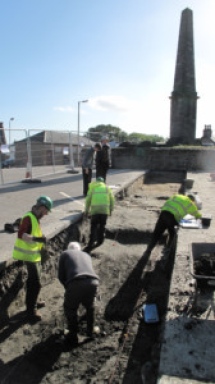Source - http://www.scotsman.com/lifestyle/heritage/viking-parliament-found-under-dingwall-car-park-1-3151064

An early 20th century photograph of Dindwall's Viking mound. Picture : Dingwall Historical Societyedieval Norse parliament.
Excavations at the Cromartie Memorial car park in Dingwall uncovered evidence of a mound that archaeologists believe was established in the 11th century as a gathering spot for a Viking parliament, known as a “Thing”.
When it was constructed the “Thing” would have been on a man-made islet in the estuary of the River Pefferey, historians claimed. They believe the mound was built on the instructions of Thorfinn the Mighty, a powerful Viking earl who died in 1065.
He is thought to have laid the foundations of what would later become the royal burgh of Dingwall in Ross-shire.
It is only the second time a “Thing” site has been uncovered in the UK. Yesterday historians said the discovery would help them learn more about the Norse Vikings, who battled for control of land across the north of Scotland.

David MacDonald, of Dingwall History Society, which was part of the dig partnership, said that a road, a ditch and an aqueduct, known as the Water of Dyke, that drew water from hillside springs, were also constructed when Thorfinn was in control of Ross-shire.
He said Thorfinn’s rise to power was aided by his victory in a battle at Torfnes on the south side of the Cromarty Firth, possibly against MacBeth’s troops. At the height of his power, Thorfinn became Lord of Caithness, Shetland and Orkney.
The origins of the town of Dingwall as a Viking Thing-site had long puzzled historians and archaeologists alike, with many believing it was elsewhere on the Black Isle in Ross-shire.
But now the results of the archaeological dig, the culmination of Highland Council’s participation as a partner in the EU Northern Periphery International Thing Project, has come up with real answers.
Mr MacDonald said: “You can call this the official confirmation of the car park being the location of a ‘Thing’.
“It has been very exciting over the years, but all the historical research points in this direction.”
In recent times historical investigation identified the Cromartie car park – which contains the burial place and memorial monument of George, first earl of Cromartie, who died in 1714 – as the site of the long lost Moothill of Dingwall, the town’s medieval meeting place. This has now been confirmed as deriving from the Viking Thing-mound.
A trial trench excavation in the car park in 2012 showed significant radio-carbon datings.
According to archaeologist Dr Oliver O’Grady, a leading authority on the assembly mounds of Scotland, who was part of the dig : “The excavations have confirmed the presence of important archaeological remains and indicated that the mound was man-made and probably created during the 11th century.
“The radio-carbon datings provide strong scientific evidence to support the interpretation that the
mound was created during the period of late Norwegian political influence in Ross-shire and wider North-east Scotland.
“The lack of substantial occupation remains or burial activity is also further circumstantial evidence that the mound was created for an assembly site or Thing.
“The substantial manpower and effort required to create a monument on the scale of the Dingwall mound would also seem in keeping with the establishment of a major regional judicial and administrative centre.”
Dingwall, which lies at the head of the Cromarty Firth, is a location on a European tourist trail of Thing sites. Funded by the EU, the Thing Sites GeoTour involves Scotland, Norway, Iceland, the Faroes and Isle of Man.